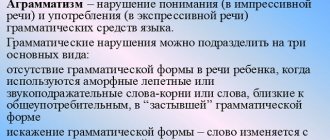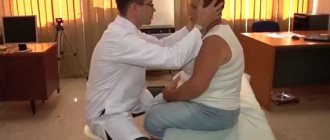You can familiarize yourself with other diseases starting with the letter “V”: Vegetative state, Ventricular, Vestibular ataxia, Vestibular neuronitis, Vibration disease, Viral meningitis, Viral encephalitis, Temporal lobe epilepsy, Intracerebral hematoma, Intracranial tumors of the cerebral hemispheres, Intracranial hypertension, Inflammatory myopathy, Inflammatory polyneuropathy, Congenital myopathy, Congenital paramyotonia, Secondary parkinsonism
Why is a vegetative state dangerous?
In vegetative states, the functions of the hypothalamus and brain stem are preserved, but the cerebral hemispheres suffer from severe dysfunction. This leads to impaired consciousness and the absence of the possibility of spontaneous mental activity. There are no signs of awareness, but the presence of unconditioned reflexes is noted. Vegetative states are characterized by periods of wakefulness accompanied by the opening and closing of the eyes. The disorder can be diagnosed clinically, but additional hardware diagnostic methods are prescribed, such as:
MRI;- Brain evoked potential study;
- Checking internal hemodynamics;
- EEG;
- PAT
As therapy, activities are carried out to stimulate the functioning of the hemispheres. In addition, the organization of high-quality patient care is required; nutrition, feeding, prevention of bedsores and possible complications.
General clinic
Vegetative looks like this:
- the patient lacks consciousness and awareness, and does not exhibit any speech activity;
- the patient does not have a purposeful manifestation of a reaction to speech and treatment, pain or other irritant;
- the patient's eyeballs are not marked by purposeful movement, although the eyes may open spontaneously, and the gaze will not focus on a specific object;
- The patient has urinary and fecal incontinence.
General information about pathology
To vegetate means to live with the preservation of all biological functions, except intellectual and social. The term was introduced in 1972. In vegetative states, a personality disorder occurs, which results in disintegration of subcortical structures and the cerebral cortex. Special standardized scales have been developed that allow the degree of disorder to be determined using characteristic clinical signs. This is done by specialists such as resuscitators, rehabilitation specialists and neurologists. Accurate instruments to assess consciousness have not yet been developed. It has not even been established to what extent the impossibility of reacting to external stimuli reflects their perception or non-perception at the level of consciousness. It is not known whether a vegetative is able to understand the speech of others, their touch, and whether any internal processes occur in his consciousness.
Autonomic dystonia in pediatric practice
Autonomic dystonia (VD) is the most common pathology of childhood and adolescence. To date, sufficient scientific data has been accumulated that reveals the versatility of the clinical, functional and socio-psychological manifestations of VD. It has been established that neurovegetative disorders underlie the development of such serious somatic diseases as hypertension, bronchial asthma, peptic ulcer, etc.
In clinical practice, pediatricians often encounter manifestations of autonomic dystonia, but the role of autonomic regulation disorders in the health of children and adolescents is often underestimated. As a rule, a pediatrician considers a disease of an internal organ as a single-organ pathology, but it must be remembered that in children vegetative changes often occur under the guise of somatic pathology or seriously worsen the course of the disease. What should a practicing physician know about the diagnosis and treatment of autonomic dystonia?
What is autonomic dystonia?
In accordance with the definition of Academician A.M. Veina, autonomic dystonia is a condition determined by a violation of the autonomic regulation of the heart, blood vessels, internal organs, endocrine glands, associated with deviations in the structure and function of the central and peripheral nervous systems. Based on the definition of autonomic dystonia (VD), disorders of autonomic regulation, as a rule, are a consequence of various pathologies of the nervous system, therefore neurologists consider VD to be a syndrome of these diseases. In some cases, these primary diseases are defined as the main diagnosis, and VD is interpreted as the syndrome of the main disease. However, pediatricians often have to deal with clinical manifestations of VD caused by neurological microorganic pathology. These are children with post-hypoxic or post-traumatic perinatal pathology, who were observed by a neurologist in infancy. In the second year of life, neurological symptoms usually disappear, but microchanges in the regulatory nervous structures remain and subsequently manifest themselves as shifts in autonomic regulation with the clinical symptoms of VD. In such cases, “vegetative dystonia” turns out to be practically the main diagnosis, the definition of which is provided for by the International Classification of Diseases, 10th revision. It must be emphasized that the main diagnosis of vegetative dystonia can be made only after excluding organic pathology, which is often characterized by similar symptoms.
The main causes of VD in children and adolescents
1. Damage to the nervous system (especially the hypothalamic and brainstem areas):
- organic pathology with a characteristic clinical picture (belongs to the competence of neuropathologists);
- micropathology caused by perinatal lesions of the central nervous system, brain injuries, and the consequences of neuroinfection. Residual perinatal changes in the central nervous system, which were already mentioned above, are the most common cause of VD in childhood. Neurologists often diagnose them with astheno-neurotic reactions or minimal cerebral dysfunction (MCD). In this case, symptoms from the internal organs often dominate, so such children are usually observed and treated by pediatricians.
2. Neurosis. The following types of neuroses are more common in childhood:
- asthenic neurosis (after illness, excessive physical or mental stress);
- obsessive-compulsive neurosis (obsessive thoughts, fears, movements).
In most cases, children with moderate signs of neurosis and symptoms of vegetative dystonia are not observed by a psychiatrist, but are treated by a pediatrician. The diagnosis of “neurosis” is usually not made by a pediatrician; in this case, vegetative dystonia is an independent diagnosis.
3. Constitutional features. First of all, we are talking about children with a neuro-arthritic type of constitution, which is often combined with undifferentiated connective tissue dysplasia syndrome. In most cases, the “vegetative portrait” is inherited through the maternal line.
4. Psycho-emotional characteristics of the child’s personality (increased personal anxiety, depressive state, hypochondriacal fixation on one’s own health).
5. Mental and physical fatigue (classes in specialized schools, sports clubs).
6. Sedentary lifestyle, as a result of which tolerance to physical activity sharply decreases.
7. Hormonal imbalance (pre- and puberty, congenital and acquired diseases of the endocrine glands).
8. Acute and chronic infectious and somatic diseases, the presence of chronic foci of infection.
9. Bad habits.
10. Other reasons: cervical osteochondrosis, surgical interventions and anesthesia, unfavorable meteorological conditions, excess body weight.
The combination of the listed causative factors occurs quite often in VD in children and adolescents.
What should you pay attention to when diagnosing VD?
When diagnosing VD, decisive importance is given to complaints and clinical manifestations, which are very diverse and can indicate both a violation of the regulation of individual organs and systems, and their simultaneous “interest”. The data from a physical examination of the child and, above all, the characteristics of the condition of the skin are of great importance. With a tendency to vagotonia, marbling of the skin, acrocyanosis, increased vascular pattern, and persistent raised red dermographism are observed. When excited, such children experience redness of the skin, hyperhidrosis of the palms, feet, and axillary areas (liquid, sticky sweat). This category of children often has allergic reactions in the form of urticaria and Quincke's edema. With sympathicotonia, the skin is pale, dry to the touch, the vascular pattern is not pronounced, dermographism is pale pink, but more often white.
The most common manifestation of VD is disturbances in the functioning of the cardiovascular system. However, it should be remembered that if the patient complains of pain in the heart, discomfort, palpitations, hypo- or hypertension and/or the doctor detects any abnormalities during a clinical examination, it is necessary to exclude organic pathology. For this purpose, a clinical blood and urine test, ECG, echocardiography, and blood pressure monitoring are performed. Depending on the results of these studies, the issue of further examination is decided. Cardialgia is often a manifestation of dystonia. Pain in the form of tingling, short-term, is usually localized in the apex of the heart. Cardialgia with VD is caused by short-term ischemia, which may be caused by a change in the tone of the heart vessels, as well as bradycardia with a rare release of blood into the coronary arteries.
Autonomic dysregulation is often the cause of various heart rhythm disorders. This is most often a bradyarrhythmia due to migration of the source of the heart rhythm. It is characterized by the absence of complaints, has a short-term ectopic rhythm (usually right atrial), is recorded in the supine position, sinus rhythm is the main one and is restored in the standing position and after exercise. Extrasystole in childhood has neurovegetative causes in almost 80% of cases. In this case, children may not feel extrasystoles or complain of interruptions (fading) and unpleasant sensations in the heart area; By their nature, the extrasystoles are single, inconsistent, recorded mainly in the supine position, and decrease after exercise and in the standing position. Frequent, especially group extrasystoles, persistent allorhythmias, combination of extrasystoles with other changes on the ECG usually have more serious causes and prognosis, although the state of the autonomic nervous system in these cases is also significant.
Supraventricular paroxysmal tachycardia in 50% of children is one of the manifestations of neurovegetative dysfunction, which develops against the background of hypothalamic syndrome, clear residual pathology or severe psycho-emotional disorders. In some children with severe vagotonia, atrioventricular block is recorded on the ECG. First degree atrioventricular block can be explained by autonomic dystonia only when organic pathology is excluded; the PQ interval exceeds the norm by no more than 0.02–0.04 ms; The blockade is not permanent and disappears after physical activity and the administration of atropine. All children with atrioventricular block should be regularly monitored by a cardiologist, since conduction disturbances can be one of the early symptoms of hereditary neuromuscular pathology (MELAS syndrome, Kearns-Sayre syndrome). In the presence of atrioventricular block, a careful collection of genealogical history, as well as an in-depth neurological examination, is necessary.
The consequence of VD may be some variants of mitral valve prolapse. The neurovegetative variant may include prolapse, which is not permanent and is characterized by the absence of regurgitation and cardiac complaints. In addition, autonomic dystonia is often combined with syndromic connective tissue pathology, which is often accompanied by valve prolapse. With such a combined pathology, the severity of prolapse may be more significant. In children with VD, physical performance and exercise tolerance are significantly reduced, which primarily reflects the reserve capabilities of the cardiovascular system. When conducting a test with dosed physical activity (bicycle ergometry) in children with dystonia, we found a decrease in tolerance to physical activity by almost two times compared to age standards. Hemodynamic changes were noted during exercise, which were most pronounced during vagotonia, which occurred with arterial hypotension. In this case, pronounced tachycardia was observed. In some patients, the heart rate was 170 beats per minute, and therefore the tests had to be stopped. Such maladaptive changes were noted as a decrease in the cardiac efficiency index and the energy consumption indicator (energy consumption by the body per unit of work performed).
Quite often, symptoms from the respiratory system are observed: periodic deep, noisy breaths, a feeling of “lack of air”, “dissatisfaction” with inhalation. Sometimes, most often when falling asleep or during sleep, wheezing inhalation and noisy exhalation are observed in the absence of auscultatory changes in the lungs and a history of bronchopulmonary pathology. Similar symptoms appear soon after emotional stress (excitement, fear, worries associated with school or family problems). Children with vagotonia are characterized by the presence of abdominal syndrome. Abdominal pain usually lasts a few minutes, but can be intense and resemble intestinal colic. Attacks of pain arise and end spontaneously. With age, the dynamics of complaints can be traced: at an early age, regurgitation and colic are characteristic, later - unreasonable vomiting with episodes of paroxysmal abdominal pain, nausea, and refusal to eat. The pain syndrome is based on dyskinesia of the gastrointestinal tract.
Metabolic and endocrine disorders are characteristic, expressed by overweight or obesity, especially in adolescents. The excess subcutaneous fat layer is distributed unevenly (mainly in the area of the buttocks and thighs), stretch marks and acne are characteristic. For most children with a parasympathetic orientation, vestibulopathy syndrome is typical, the manifestations of which are dizziness at the sight of moving objects, poor tolerance to transport and stuffy rooms. Vestibulopathy syndrome is caused by a functional connection between the vagal and vestibular nuclei. There are disturbances in thermoregulation. Children with sympathicotonia with intercurrent illnesses are characterized by febrile temperature (39–40°). The skin is usually pale. At high temperatures, determined in the axillary regions, the forehead and extremities are relatively cool, and temperature asymmetry is often detected (the temperature difference in the axillary regions can be 0.4° or more). After recovery from an intercurrent illness, children with vagotonia may have a low-grade fever for a long time, which is a cause for concern for parents and continued examinations and consultations. In addition, increased attention to this symptom and frequent measurement of body temperature can contribute to the formation of neurotic reactions in the child.
Basic principles and methods of treatment of VD
Treatment of autonomic disorders is based on the following principles:
- pathogenetic approach to the treatment of VD, since symptomatic treatment gives only a temporary, unstable effect;
- long treatment periods, since it takes considerable time to restore balance between the sympathetic and parasympathetic parts of the autonomic nervous system;
- an integrated approach, including various types of effects on the body;
- selectivity of therapy depending on the type of VD.
Currently, non-drug and drug treatment methods are generally accepted. In children and adolescents with moderate manifestations of VD and a short period of impairment, it is advisable to use non-drug therapy. In case of severe and long-term symptoms, in addition to non-drug therapy, medications are prescribed. Non-drug therapy includes proper organization of work and rest; maintaining a daily routine; physical education classes; balanced diet; psychotherapy; hydrotherapy and balneotherapy; physiotherapy; massage; aromatherapy; acupuncture (according to indications). The daily routine, especially sleep, is of paramount importance, as it contributes to the synchronization of the body's circadian biorhythms, in particular the biorhythms of the functional activity of the cardiovascular, sympathoadrenal and parasympathetic systems. From the perspective of chronobiology, autonomic dystonia can be considered as a violation of the synchronization of the circadian biorhythms of the sympathetic and parasympathetic nervous systems, that is, as desynchronosis of the autonomic nervous system.
In the sleep-wake cycle, there are 7 repeating functional states: tense wakefulness, wakefulness, relaxed wakefulness, drowsiness, shallow slow-wave sleep, deep slow-wave sleep, REM sleep. According to F.I. Komarov and S.I. Rappoport, the most significant are intense wakefulness, which forms the basis of functional performance, as well as deep slow-wave sleep, which determines the body’s adaptation capabilities. That is why normalization of sleep is an integral part of complex therapy for VD. In practical work, we very often encounter misunderstandings of the importance of non-drug therapy on the part of patients’ parents. Parents want to receive medicinal treatment, and not boring recommendations about a healthy lifestyle, seek to exempt the child from physical education, demand numerous consultations with specialists and unreasonable examinations. Drug therapy is prescribed in combination with non-drug drugs or if the latter are ineffective. When prescribing drug therapy, the following basic principles should be adhered to:
- differentiated approach to prescribing sedative or tonic herbal medicine;
- drugs of chemical origin are preferably used as monotherapy. In the absence of positive dynamics, a change of drug is indicated;
- combination therapy (two or more drugs) is prescribed if monotherapy is ineffective or with severe manifestations of VD;
- After achieving the effect of drug therapy, non-drug treatment should be continued.
Sedative herbal medicines can be prescribed for both sympathicotonia and vagotonia. However, the frequency and time of taking drugs during the day are different. For sympathicotonia, sedative herbal medicine is prescribed 3 times a day (morning, afternoon, evening), for vagotonia - 1 time a day (in the afternoon). It is possible to take medications on an unscheduled basis in case of anxiety, psycho-emotional stress (before an exam, test, etc.). Regular course use of sedative herbal medicine allows, as a rule, to avoid the use of tranquilizers (anxiolytics) and antipsychotics. It should be noted: when it comes to prescribing herbal sedatives to children, it must be remembered that there are exceptions to the rules. This applies to children aged 2–5 years, among whom there are often cases of severe anxiety and negative behavior, often not subject to any other correction other than pedagogical. According to V.M. Studenikin, this behavior is due to the peculiarities of children’s adaptation to the environment with the relative immaturity of the psycho-emotional sphere. In these cases, sedative herbal medicine has little effect.
Herbal remedies (adaptogens), which have a stimulating effect on the central nervous system and the sympathetic division of the ANS, are prescribed to children and adolescents with vagotonia, the leading manifestations of which are lethargy, lethargy, apathy, decreased performance, and increased drowsiness. Medicines are prescribed only in the first half of the day. Children and adolescents with manifestations of dystonia, who have suffered perinatal encephalopathy and have residual organic changes in the central nervous system, are advised to undergo a course of treatment with neurometabolic drugs - nootropics. According to WHO experts, nootropic drugs are drugs that have a direct activating effect on the central nervous system, improving memory, mental activity, learning ability, and also increasing the resistance of the central nervous system to psycho-emotional stress. Nootropics - piracetam, pyriditol, aminolone, picamilon, glutamic acid - are characterized by a distinct stimulating effect. The use of these drugs is advisable for vagotonia.
In the presence of increased excitability, a decrease in the threshold of convulsive readiness (according to EEG data), the use of nootropics with a sedative effect is justified - phenibut, pantogam, glycine, etc. These drugs are the drugs of choice for sympathicotonia. In recent years, in the treatment of VD, drugs have begun to be used that have a multifactorial effect, which improve microcirculation, blood supply to the brain, its oxygen supply, and also activate cellular metabolism. In pediatric practice, drugs such as cinnarizine (Stugeron) and vinpocetine (Cavinton) are widely used. In addition, the drugs ginkgo biloba (Tanakan and others), nicergoline (Sermion), vincamine (Oxibral), Vasobral, Instenon, Actovegin are very promising in the treatment of VD. An effective way to correct autonomic disorders is to prescribe vegetative drugs, which are a kind of autonomic correctors that normalize the functional state of the ANS and hypothalamus. The most commonly used drugs are Bellataminal, Bellaspon and Belloid, which have both adrenolytic and anticholinergic activity. These drugs are indicated for severe vagotonia with vestibulopathies, headaches, and a tendency to faint. These drugs are part of complex therapy for various arrhythmias, sinus node dysfunction, and bradycardia.
Therapy of VD occurring with cardiac disorders
In case of autonomic dysregulation, which is the cause of cardiac changes (extrasystole, various tachyarrhythmias, conduction disturbances, nonspecific changes in the repolarization process in the myocardium), in order to prevent myocardial dystrophy and normalize cardiocerebral interaction, the administration of membrane-stabilizing drugs with energy-tropic and antioxidant effects is indicated. Among them, the drugs of choice are ubiquinone, L-carnitine, Limontar, flavonoids, Mexicor, Mexidol, lipoic acid, B vitamins. The prescription of energy-tropic and antioxidant drugs is due to the fact that autonomic imbalance with increased tone of the sympathoadrenal or parasympathetic system is accompanied by increased energy needs of various organs and tissues and wasteful use of oxygen, which leads to the development of hypoxia and deficiency of ATP, the main source of energy in the cell. The resulting intracellular acidosis, changes in electrolyte balance, and the accumulation of under-oxidized fatty acids contribute to increased lipid peroxidation processes, which leads to dysfunction of mitochondria and worsening energy deficiency in the body, especially in the brain and heart.
A significant role in the synthesis of ATP is given to the obligatory energy-producing component of every cell - coenzyme Q10 (ubiquinone). The cell needs a constant supply of coenzyme Q10 in sufficient quantities. Studies have shown that a 25% deficiency of coenzyme Q10 is a prerequisite for the development of pathological processes. In addition, coenzyme Q10 has pronounced antioxidant activity, which helps maintain cell integrity. The uniqueness of CoQ10 as an antioxidant is that, unlike other antioxidants, its active form is constantly restored by enzymes. Coenzyme Q10 is able to restore the activity of vitamin E. An important role in maintaining the stability of cell membranes is given to antioxidant vitamins A, C, E and microelements: zinc, selenium, etc. Currently, there are a number of drugs containing coenzyme Q10 (Ubiquinone, Coenzyme Q10, Coenzyme Q10), most of them contain fat-soluble ubiquinone, which has very low digestibility. The results of domestic and foreign studies indicate that the digestibility of water-soluble forms of ubiquinone in the intestine is significantly higher than that of fat-soluble ubiquinone.
In our country, the drug Kudesan, which contains water-soluble coenzyme Q10, has been developed and is actively used in pediatric practice (ZAO Akvion, Russia). Kudesan is created on the basis of modern technology, which makes it possible to convert fat-soluble substances into microencapsulated form, which ensures maximum absorption and, therefore, the greatest effectiveness of the drug. Specialists from the Department of Pediatrics of the Russian Medical Academy of Postgraduate Education have been working with this drug for several years. Moreover, we assessed the effectiveness of Kudesan in children and adolescents with VD accompanied by cardiac disorders. The study included 50 children and adolescents aged 8 to 16 years. The selection criterion for children and adolescents was a violation of repolarization processes in the myocardium, usually in combination with other electrocardiographic changes: sinus tachycardia; migration of pacemakers; atrial rhythm; supraventricular electrosystole; transient conduction disturbance (1st degree AV block and 2nd degree sinoatrial block). In 11 patients, short-term cardialgia, palpitations, sensations of increased heart contractions were observed, appearing during physical activity and with excitement, less often at rest.
To assess the effect of Kudesan therapy, the examined children and adolescents were randomized into two groups comparable in age, gender, nature of cardiac changes and type of dystonia: group 1 (30 people) received Kudesan therapy during treatment for VD; Group 2 – 20 people in whom dystonia therapy was combined with placebo (distilled water). Therapeutic doses of Kudesan were: for children under 10 years old – 30 mg/day; over 10 years – 45 mg/day. Course duration – 1 month. In order to correct autonomic dysregulation, various non-drug treatment options were used (physical therapy, massage, group or individual auto-training), as well as taking vitamin and mineral complexes. Drug therapy (nootropic and cerebrovascular drugs) was prescribed differentially (according to indications). During the treatment period, other energy-tropic and cardiotrophic drugs were not used.
The effectiveness of Kudesan therapy was expressed in positive ECG dynamics in group 1. Analysis of the final part of the ventricular complex showed that normalization of repolarization processes in the myocardium was observed in 45% of patients in group 1, while in group 2 (comparative) it was observed in only 15% of subjects. A clear improvement in the repolarization process was noted in group 1 – in 46%, while in group 2 – in 35% of subjects. A slight improvement (clinical only, without ECG improvement) was determined in the 1st group - in 9%, in the 2nd group - in 50% of the subjects. In the 1st observation group, in addition to the positive dynamics of repolarization processes in the myocardium, the frequency of registration of sinoatrial blockade of the second degree, AV blockade of the first degree decreased, and episodes of pacemaker migration disappeared in most patients. This led to a decrease in the number of patients with arrhythmia and bradycardia. The heart rate during sinus tachycardia did not change significantly.
Analysis of the results showed that Kudesan therapy in most cases is effective not only in cases of changes in repolarization processes in the myocardium, but also in cases of disturbances in heart rhythm and conduction. The positive dynamics of cardiac changes was combined with a pronounced decrease in the manifestations of VD (normalization of sleep, absence of severe fatigue, cessation of complaints of headache, cardialgia, palpitations). In conclusion, we note: only a consistent, comprehensive, individual, etiopathogenic approach to the treatment of vegetative dystonia with multisystem manifestations will make it possible to control its course, prevent the progression of disorders and significantly improve the quality of life of children and adolescents with vegetative-vascular dystonia.
Causes
Cerebral dysfunction begins due to factors damaging the brain, which are the causes of the syndrome. Etiological factors are classified according to their mechanism of action:
Metabolic, causing acute intoxication and hypoxia. These may include the use of drugs, an overdose of which causes toxic damage to brain cells. In addition, such damage to cerebral structures can provoke acute dysmetabolic conditions, which include hepatic coma, uremia, hypo- and hyperglycemia caused by diabetes, as well as poisoning with neurotropic poisons;- Severe TBI, diffuse axonal damage, and brain contusions are considered mechanical factors. In fifty percent of cases, they cause a coma that turns into a vegetative state;
- Intracranial hemorrhages, brain tumors, meningitis, encephalitis and other infectious lesions are organic causes caused by changes in cerebral tissue.
Mechanism of development of the vegetative state
Under the influence of damaging factors, connections between the subcortical centers and the reticular formation are broken, which causes coma. When lost connections are restored, the functioning of the remaining synapses is strengthened, new interneuronal contacts are formed and neurotransmitters are reactivated, the coma is exited, which is characterized by an “awakening reaction,” that is, the patient opens his eyes. After this, a gradual restoration of consciousness begins. If recovery remains in the awakening phase, VS occurs. Experts suggest that it occurs during pathological processes of reintegration.
Characteristic signs of a vegetative state are extensive damage to the subcortical substance and diffuse necrotic changes in the thalamus and cortex. Atrophy of demyelination of subcortical structures also occurs, but much less frequently. According to some experts, the leading role in the mechanism of development of VS belongs to the activation of the process of removal of defective cells by the body.
Symptomatic picture
In a vegetative state the following is observed:
Preservation of vital functions: breathing, cardiovascular activity, digestion, chewing and swallowing reflex of tear production;- The ability to involuntarily move the eyes, blink, exhibit unfocused motor activity, grind teeth, grasp objects located near the hand, and respond to pain impulses is preserved;
- There are no signs of awareness of what is happening, no contact with the outside world;
- There are periods of wakefulness when a person lies with his eyes open. He is able to move his eyeballs slowly, but this is not a conscious gaze. When there are flashes of light and loud sounds, the patient reacts;
- In the absence of speech, the ability to produce isolated guttural sounds and deep sighs is retained, which can give untrained people the erroneous impression that they are emerging from a vegetative state. But that's not true. The first signs of exiting the VS are gaze tracking, gaze fixation, a state of small consciousness in which the patient can fulfill simple requests: clench his fingers, show his tongue.
The duration of a vegetative state can range from several months to 10 years. Persistent VS is diagnosed when symptoms persist for more than a month. Permanent is characterized by the persistence of symptoms for more than a year in a post-traumatic vegetative state and more than three months in a non-traumatic genesis.
Treatment tactics and prognosis
Previously, it was believed that neurons do not have the ability to recover. However, recent studies reliably indicate the possibility of restoring nerve conduction even in the presence of extensive damage. The Clinical Brain Institute uses progressive techniques aimed simultaneously at several aspects:
- the formation of new neurons from precursor cells that can transform into nerve tissue;
- increased conductivity in undamaged areas,
- proliferation of processes of healthy neurons.
All these techniques significantly improve the prognosis and increase the patient’s chances of gradually returning to a normal lifestyle and restoring lost skills.
Therapeutic techniques
Therapy for a vegetative state involves round-the-clock monitoring and care of the patient. If there is no need to use artificial life support devices, treatment can be carried out at home. Doctors at the Clinical Brain Institute adhere to a comprehensive tactic that includes 4 main stages.
- The first stage is the restoration of nerve conduction with medications and additional techniques. There is information about positive dynamics when using drugs of the amphetamine group. Artificial stimulation with visual, sound, pain and other stimuli is also used.
- The second stage is aimed at preventing complications caused by an immobile lifestyle. The patient is prescribed procedures such as massage, performing passive movements, and frequent changes of body position. It is also important to adhere to the rules of asepsis and antisepsis when placing catheters and performing injections to prevent bacterial contamination.
- The third stage is feeding the patient. It should be compiled taking into account the body's needs for calories, vitamins, micro- and macroelements. Despite the fact that in some cases the chewing and swallowing reflex is preserved, nutrition is supplied artificially. When feeding a patient through a tube, complications are possible (aspiration, reflux, damage to the mucous membrane), so the decision to create a gastrostomy is often made.
- The last stage is caring for the patient and maintaining hygiene rules. It is necessary to regularly brush teeth, bathe the patient, and ensure clean clothes and bed linen. It is also important to treat the skin with moisturizing ointments and change body position to avoid bedsores.
Treatment tactics are selected individually, taking into account the patient’s age and duration of stay in a vegetative state. In case of persistent VS, methods of restoring nerve conduction can be effective; in case of permanent VS, the main goal of treatment remains the maintenance of vital functions and the prevention of complications.
Prognosis for a vegetative state
The prognosis depends on many factors, including the age of the patient. Young people will experience faster recovery of nerve conduction than older people, all things being equal. If a person spends less than 3 months in a vegetative state, the chances of reconnecting with the environment are much higher. However, it will not be possible to fully recover - in most cases, a history of VS causes severe disability. If VS continues for six months or more, the likelihood of renewing neural connections gradually decreases. In this case, treatment is not aimed at rehabilitation, but at preventing the following complications:
- bedsores;
- muscle contractures;
- thrombosis - in a supine position, the blood becomes thicker, resulting in an increased risk of blood clots.
The Clinical Brain Institute specializes in the diagnosis and treatment of patients with traumatic brain injuries, bruises and other injuries to the central nervous system. The work uses progressive techniques that are selected individually for each patient. It is worth understanding that the prognosis for a vegetative state also depends on the chosen treatment tactics and the timeliness of a complete diagnosis - despite the fact that nerve cells are restored, all therapeutic methods are most effective in the first stages of the disease.
Clinical Brain Institute Rating: 5/5 — 6 votes
Share article on social networks
Diagnostic methods
The diagnosis is made by a neurologist based on characteristic signs: lack of awareness, preservation of unconditioned reflexes, sleep-wake phases. To assess the metabolism of bioelectrical activity of the central nervous system and cerebral hemodynamics, hardware diagnostic methods are required:
The study of evoked potentials can demonstrate anatomical interruption of cerebral tracts. It is worth considering that the resulting picture will be heterogeneous;- Electroencephalography is capable of recording paroxysmal bursts, delta and theta rhythms, and occasionally an alpha rhythm close to normal may appear;
- Ultrasound scanning of intracranial vessels helps to clarify the state of vascular blood flow. With VS, there is difficulty in perfusion and impaired venous outflow;
- Magnetic resonance imaging shows nonspecific changes in soft tissues: an increase in the volume of the ventricles and subarachnoid space, signs of atrophy. With a high degree of probability, the degree of atrophy makes it possible to make an expected prognosis about exit from the VS;
- PET allows you to detect the degree of decrease in metabolic processes in the cortex. In persistent vegetative states it decreases by 50%, and in permanent ones by 30-40 percent. During activation of the multifunctional area of the associative cortex, the exit from the VS begins.
To differentiate VS from coma, it is necessary to check the integrity of unconditioned reflexes, the change in sleep-wake phases and the presence of eye opening under light and sound influences. In coma, these signs are absent.
Therapy
Recent research has refuted the assertion that adult nerve cells are not capable of self-healing. To achieve this, the body has a mechanism for transforming stem cells and cerebral progenitor cells into neurons. The processes of surviving nerve cells grow and reserve areas of the brain are used. Treatment of vegetative-vascular conditions includes activation of the listed compensatory processes. It must be accompanied by the prevention of complications and quality care. Therapy includes:
Artificial nutrition that can fully provide the body with the necessary amount of microelements, vitamins, calories and proteins. Since tube feeding causes complications in the form of mucosal ulcers, gastroesophageal reflux, and aspiration, preference should be given to nutrition using a gastrostomy tube;- Pharmacological therapy and regular sensory stimulation designed to stimulate the restoration of consciousness. For this purpose, auditory, visual, painful, tactile, and olfactory stimuli are used with a gradual increase in intensity and time of exposure. This allows you to eliminate sensory hunger that prevents you from leaving the sun. In addition, recently a positive effect has been recorded from taking amphetamines. The search for a successful method of activating cerebral reintegration continues; in Japan and France, targeted electrical stimulation of the brain stem is now being tested;
- High-quality care, including maintaining adequate skin moisture, posture control, teeth brushing, and regular linen changes.
In addition, it is very important to carry out prevention and treatment of complications, which includes:
- Correct installation of catheters;
- Timely change of diapers;
- Massage;
- Changing the patient's posture;
- Planting with the help of orthopedic systems, designed to prevent secondary infections;
- Correction of muscle tone with medications;
- Passive movements to combat contractures;
- Treatment of contractures using tenotomy.
With permanent VS, it is necessary first of all to prevent complications. In case of persistence, brain stimulation is indicated.
Complications
Due to the almost complete immobility of patients in the VS, joint contractures, bedsores, and congestive pneumonia develop. The need for constant catheterization of the bladder causes the risk of infection of the urinary tract with the development of pyelonephritis and urosepsis. These complications can cause the death of the patient. Possible sudden death. Careful care, prevention of bedsores, and necessary supportive therapy can prevent the development of complications and prolong the patient’s life.
Prognosis for vegetative states
It is possible to make any predictions only based on the cause of occurrence, the duration of the coma and the period of VS, the age and general condition of the patient. If the condition was caused by non-traumatic etiological factors, then recovery will take about 3 months, and at least a year if the factors that caused the vegetative state were traumatic. Cases of improvement were noted at a later date. In younger patients, motor activity returns more quickly. In most of the reported cases, restoration of brain function to the previous level does not occur. The consequence of VS is severe disability. If a vegetative is in this state for more than six months, then with good care and medical supervision, the survival rate is ¼ of all cases.










